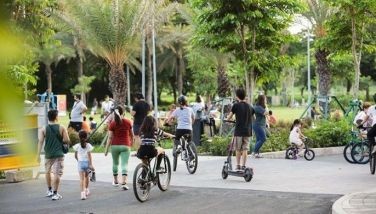Bohol bids for UNESCO Global Geopark title
CEBU, Philippines — Bohol has a set of 10 geosites to start with in its bid to be declared as Global Geopark by the United Nations Educational, Scientific and Cultural Organization (UNESCO).
Dr. Patrick Kames McKeever Secretary of the International Geosciences and Geoparks Programe of UNESCO will be coming to Bohol on July 23-27 to evaluate these sites, leading to the possible UNESCO declaration of the province as a Global Geopark.
The UNESCO National Commission of the Philippines (UNACOM) and the University of the Philippines (UP) School of Urban and Regional Planning (UP-SURP) groomed and nominated Bohol for the UNESCO Geopark declaration, which will be a first for the Philippines, if ever.
Governor Edgar Chatto and Freddie Blanco, UNACOM development management officer and program officer for Science and Technology, had invited McKeever last June 28, via UNACOM deputy executive director Lindsay Barrientos, “to visit Bohol to conduct an assessment of its potentials and discuss with the local stakeholders.”
Chatto had introduced Bohol as the 10th largest island in the Philippines, located in Central Visayas, “with a population of 1.3 million and is richly endowed with geological, archaeological, biological and cultural assets which we believe are important ingredients of a geopark.”
Bohol’s 10 proposed geosites that UP-SURP, UNACOM, and the provincial government have listed are: the Alicia Schist in Alicia town; Lamanoc Island in Anda; Philippine Tarsier and Wildlife Sanctuary in Corella; Chocolate Hills in Carmen; Uplifted Marine Terraces in Maribojoc and Loon; Hinagdanan Cave in Dauis; Balicasag Marine Sanctuary in Balicasag Island; Baclayon Church; Loboc Church Ruins; and the newly restored Dauis Church in Dauis.
In his letter, Chatto described Alicia Schist as “an elongated body of foliated rocks located in Alicia town, believed to be from late Jurassic to early Cretaceous in age, making it the “Oldest Rocks” of the province.
Lamanoc Island in Anda is “one of the hidden gems of Bohol for its unspoiled forest, intriguing caves, and fascinating overhanging rocks that sometimes make islet appears to magically hover above the blue sea.”
Chatto said the provincial government had created the Tarsier Sanctuary as “the home of the endangered smallest primate in the world for the conservation and preservation of habitat, promotion of ecotourism, as well as, environmental awareness and provide a research program for national and international primatologists.”
Chocolate Hills in Carmen, has been described as “one of the most unique Cone-Karst landscapes in the world formed approximately one to five million years ago. Its unique morphology is a reflection of Bohol’s structural and tectonic history;” also known for its “marvelous brown chocolate color during the summer months.”
The Uplifted Marine Terraces in Maribojoc and Loon is “a unique geological feature which was created during the 7.2 magnitude Great Bohol Earthquake in 2013.” Known as the “Loon-Maribojoc Geological Monument” the uplifted coastal area covers 137 hectares or 1.37 square kilometers of coastline stretching eight kilometers.”
For Hinagdanan Cave in Dauis, Chatto said it “is naturally made of limestone, a lighted cavern with a deep lagoon and about 100 meters long of beautiful rock formations presented by large stalactites and stalagmites.”
The “Balicasag Marine Sanctuary in Balicasag Island is a 400-meter marine sanctuary of healthy corals and various pelagic organisms. Various diving experiences are offered in the island from submarine cliffs and underwater caves, he said.
For Baclayon Church, Chatto said it “was founded by the Jesuit priests in 1596 and became the oldest Christian settlement in Bohol, and the second oldest church of the Philippines.” It was partially damaged by the 7.2 magnitude Bohol quake but was “fully restored in the following years.”
The Loboc Church Ruins in Loboc “became the second Christian settlement in Bohol as it was established by Jesuits in 1602, and the present coral stone church was completed in 1734.” Classified as a National Historical Landmark by the NHCP and a National Cultural Treasure by the National Museum of the Philippines, it was also damaged by the 2013 earthquake.
The newly restored Dauis Church in Dauis “is one of the erstwhile churches in Bohol and a fine rendition of Byzantine-Romanesque architecture. It was founded by Jesuits Father Diego de Ayala and Joseph Gregorio.” Its construction “was conducted by Father Julio Saldana in 1863 and was completed in the early 1920’s.” After its damaged due to the 2013 quake, “it was fully restored in 2017,” according to Chatto.
Having these 10 proposed geosites, the provincial government hopes that Dr. Mc Keever’s assessment on them “would eventually merit the approval of UNESCO to be part of the Global Geoparks Networks in the Asia-Pacific and the world,” Chatto added. (FREEMAN)
- Latest






















